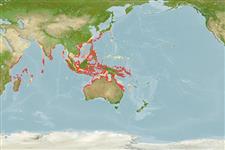Common names from other countries
Environment: milieu / climate zone / depth range / distribution range
বাস্তুসংস্থান
রীফ সংশ্লিষ্ট; গভীরতার পরিসীমা 0 - 30 m (Ref. 848). Tropical; 36°N - 27°S, 40°E - 160°E (Ref. 848)
Indo-West Pacific: Mozambique to Papua New Guinea, north to Japan and south to Australia.
Length at first maturity / আকৃতি / ওজন / Age
Maturity: Lm ? range ? - ? cm
Formation: often consists of few corallites, but may be large and hemispherical. Corallites: large, phaceloid, mostly monocentric. Septa: with tall sharp teeth. Polyps: thick, fleshy, with rough surface. Color: blue gray, with pale valley floors or septo-costae at times. Corallites of the same colony have same coloration (Ref. 848).
Occurs in most reef environments (Ref. 848).
Life cycle and mating behavior
পরিপক্কতা | প্রজনন | ডিম ছাড়া | ডিমসমূহ | ডিম্বধারন ক্ষমতা | শুককীট
Members of the class Anthozoa are either gonochoric or hermaphroditic. Mature gametes are shed into the coelenteron and spawned through the mouth. Life cycle: The zygote develops into a planktonic planula larva. Metamorphosis begins with early morphogenesis of tentacles, septa and pharynx before larval settlement on the aboral end.
Veron, J.E.N. 2000. (Ref. 848)
IUCN Red List Status (Ref. 130435)
CITES status (Ref. 108899)
Not Evaluated
Human uses
| FishSource |
হাতিয়ার
ইন্টারনেট সুত্র
Estimates based on models
Preferred temperature
(Ref.
115969): 25 - 29.3, mean 28.6 (based on 2761 cells).
Price category
Unknown.
